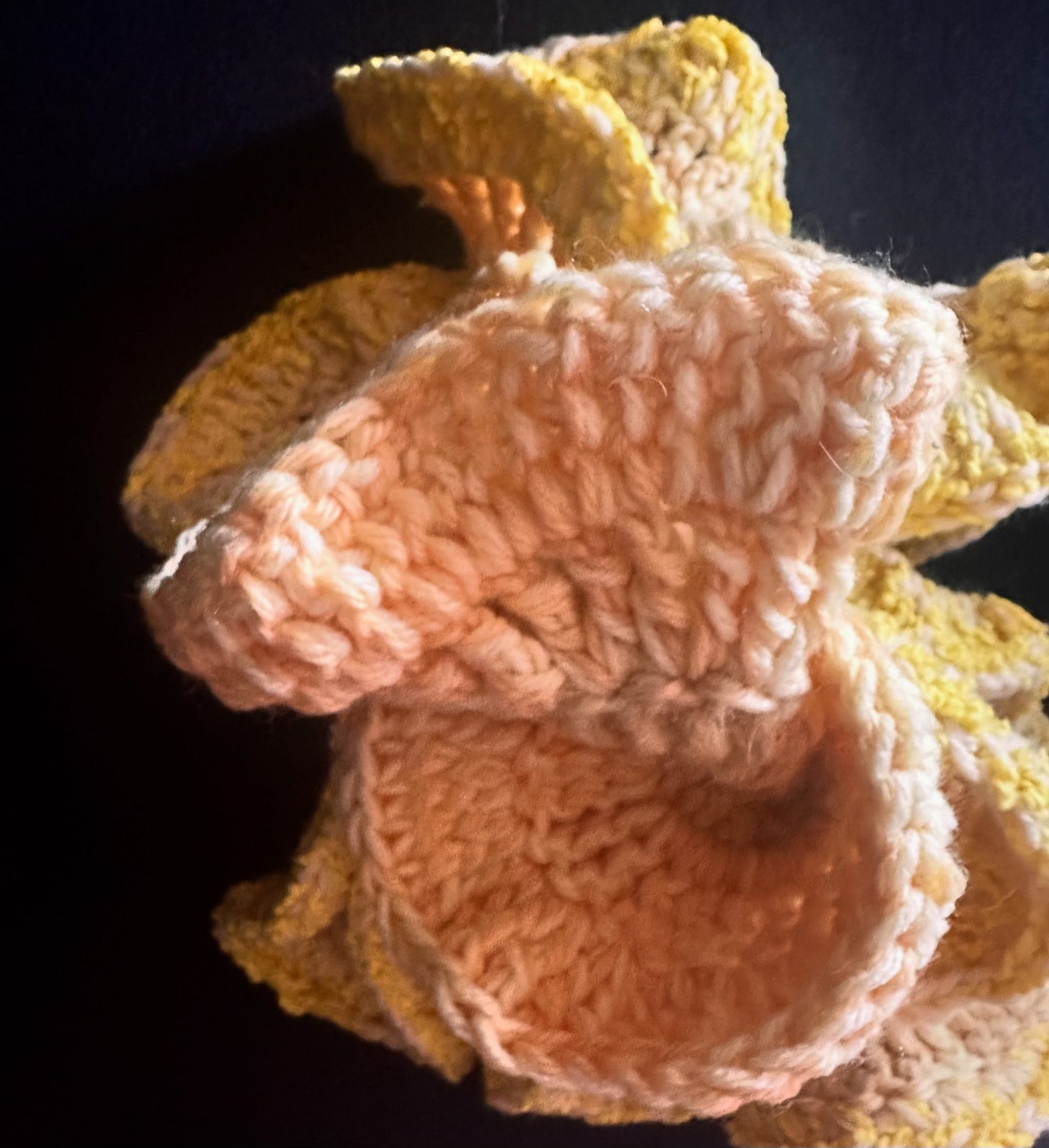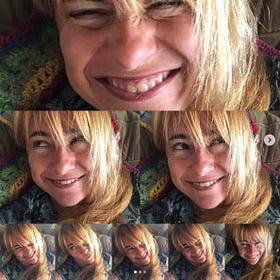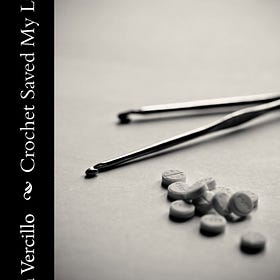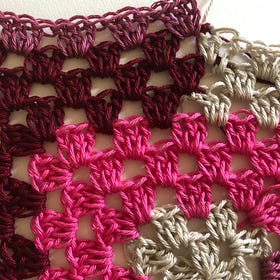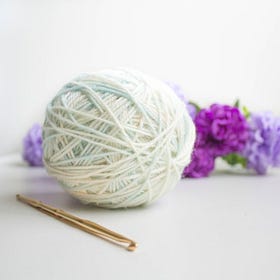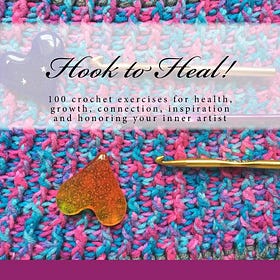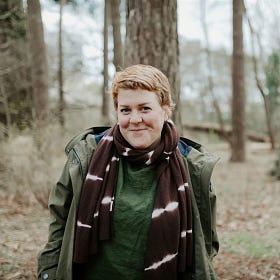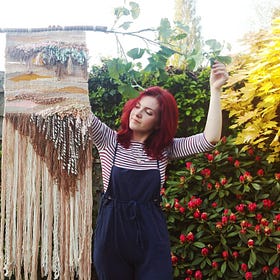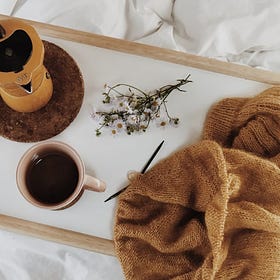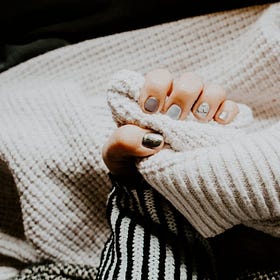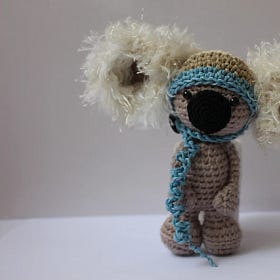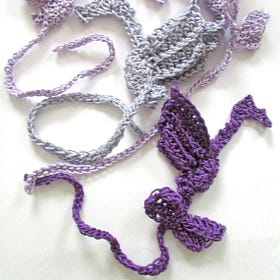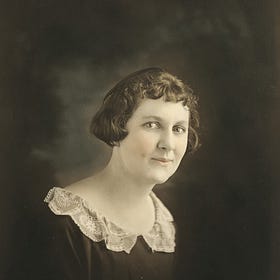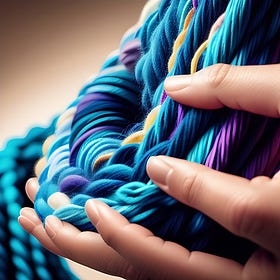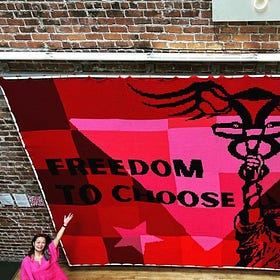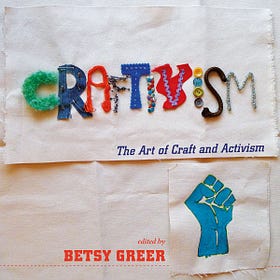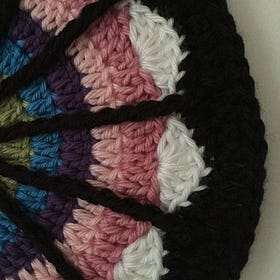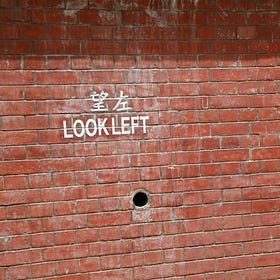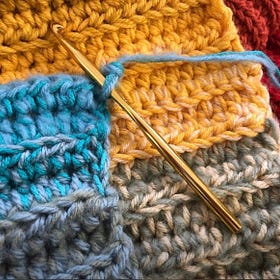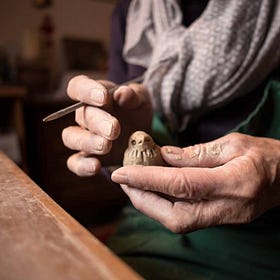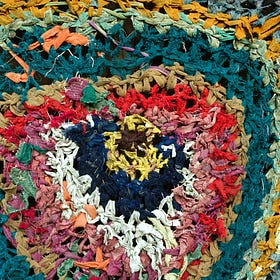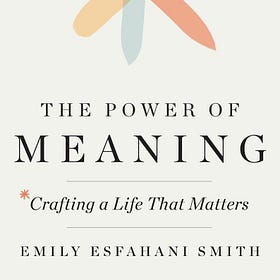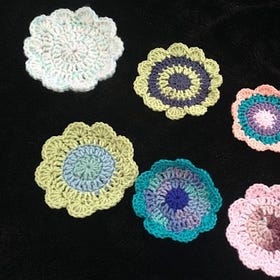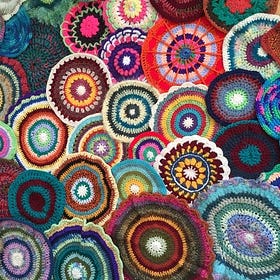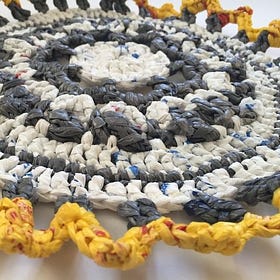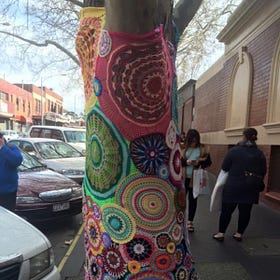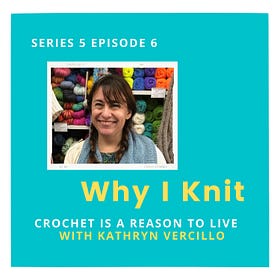Essay Collection: Crochet/Craft As Therapy
From Many Years Spent Exploring the Healing Benefits of Handcrafts
I’ve been writing about the complex relationship between art and mental health for many years now.
It started with a specific interest in the mental and physical health benefits of crochet.
I interviewed 2 dozen women about that for my book, Crochet Saved My Life.
I interviewed hundreds more over the years for various online and print articles including 8 years writing the monthly Crochet Heals column for Happily Hooked Magazine.
I created 100 exercises for using crochet to improve various areas of life for my book Hook to Heal, a book which has been used by therapists and mentors in prisons, substance recovery centers and other institutions.
I launched a collaborative online project that turned into a book and California art exhibits to raise awareness about depression, suicide, and crafting to heal as a response to the death by suicide of crochet designer Mandalas for Marinke whose story had been in Crochet Saved My Life.
Then I expanded into exploring the therapeutic benefits of other crafts. And eventually to the current niche of looking at the more complex and shadowed relationship between art/craft and mental health.
I sometimes share writing I’ve done about crochet as therapy/crafting to heal. Explore those essays below; they are organized into the categories:
Excerpts from Crochet Saved My Life
Therapeutic Crochet Exercises from Hook to Heal
Interviews about Craft as Therapy
Craftivism
Other Essays on Craft as Therapy
Mandalas for Marinke awareness raising
And more … (podcasts, audio, other stuff)
Excerpts From Crochet Saved My Life
The Early Days of My Depression Story and How Crochet Came to Help
Today I can look back through the tunnel of depression from the other side. From here, I can see that my first obvious battle with depression began when I was 14. What you will learn about me as I continue on with my personal story is that I often dealt with, acted out and ultimately worsened my depression in direct relationship to the man in my life at the time. It is a classic story for women dealing with depression but obviously I didn’t see it as such at the time. I’ll foreshadow the future of my story by saying that there’s a lot of strength in being a girl alone with a crochet hook instead of a girl alone in someone else’s bed.
Crochet/Craft to Break the Cycle of Rumination and Reduce Depression Symptoms
For context, this excerpt below follows a section in the book on what mindfulness practice is and how to use crochet / craft to practice mindfulness. Now we move into the section called “Breaking the Cycle of Rumination,” which was one of my biggest challenges when first learning to heal my own depression.
Margaret's Story of Crochet Healing Depression
Margaret Mills is part of a three-generational household of women crafters. Her mom quilts, her daughter explores a variety of fiber arts and Margaret both crochets and sews. Crocheting has helped her feel better during a bout of depression.
Blind Crocheters and Visually Impaired People Who Crochet
You don’t have to be able to see to crochet. You can feel your way through the work. In fact, many people who crochet are blind – either because they were born that way or because they experience macular degeneration over time. For many, including those who are blind or visually impaired, crochet isn’t just about creating something beautiful—it’s about reclaiming control and finding peace in a world that often feels out of reach. Many older people with limited eyesight can no longer drive or do other daily things but they can still crochet. Here is a collection of stories I’ve learned over the years about inspiring blind and visually impaired crocheters
Therapeutic Crochet Exercises From Hook to Heal
Thoughts on Letting Go, Releasing, and the Importance That I Stop "Shoulding" On Myself
Each chapter in this book introduces a topic where we might need some healing practice then provides my original crochet exercises for working through those challenges along with Yarn for Thought to dig deeper into the questions asked and what arises as the person crafts. This is the introduction to that second chapter. I wanted to share it here today because I’ve been reminded recently of the important tip to be gentle with myself and that relates specifically to how hard it can sometimes be to creatively pivot, change, release, let go.
Self-Care Exercise: Crochet as Part of Your Sleep Routine
As the title indicates, there aer one hundred original crochet-for-self-improvement exercises in my book Hook to Heal!: 100 Crochet Exercises For Health, Growth, Connection, Inspiration and Honoring …
Facing Fears and Trying New Things: Guest Post and Excerpt by Maggie Maris + Crochet Exercise by Kathryn Vercillo
The 100 exercises are divided into ten categories, with ten exercises each, and one of those categories is, of course, Facing Fears. I share some of my own stories about facing fears and provide various exercises for working through different fears including fear of change, new things, and the unknown, fear of not being perfect, not being good enough and fear of rejection.
Interviews about Craft as Therapy
Slow Crafting: An Interview with Writer/Artist Yarrow Magdalena
I recently came across Yarrow Magdalena, a web designer (writer/artist/researcher) who embraces the art of slow crafting. One description of their work cites that in addition to an interest in textile art and history, they appreciate “slow, therapeutic crafts for mental health + ptsd” and enjoy “DIY comfort items.” That’s right up my alley.
Sophie of Wallflower Weavings Shares The Mental Health Benefits of Weaving
Although I’m mostly a crocheter, I do some other fiber arts as well, including a little bit of frame loom weaving. Sophie’s rich texture, color choices, and the detail in her weavings always appealed to me; just looking at them sometimes felt a bit therapeutic. Therefore, I was thrilled when I saw a post mentioning that she finds weaving to be healing. I asked if she would be willing to do an interview, and she generously shared her thoughts on the mental health benefits of weaving.
Crochet Heals Interview: Ecocrafter The Crafty Therapist
Janferie MacKintosh, better known online as The Crafty Therapist, is a complementary therapist, ecocrafter, and a crochet pattern designer living in The Scottish Highlands. She’s also a mom to three boys who reap the benefits of her crafty ways in the form of adorable wearables. Jan learned to crochet as a child, but she came back to the craft after the loss of a baby. Crochet can help people heal through the worst of challenges including bereavement.
Knitting Heals: Interview with Stroke Survivor Rebecca Robinson
In response to some of the work I’ve been doing about crafting to heal, I received a wonderful comment from Rebecca Robinson about how knitting heals as a form of physical / occupational therapy, which she herself used after a stroke and brain bleed. Interestingly, she wasn’t able to use crochet the same way. I wanted to know more and was thrilled when she agreed to an interview.
A Scientist Shares How Knitting Helped Her After Having a Stroke
Mary shares, "I’m a biologist by education, with a minor in psychology. In other words, I’m a scientist. I am used to research and advanced language. Having a stroke, with aphasia, was extremely frustrating for me. I needed to do something hands-on to create new pathways in my brain so that I could heal."
Crochet Heals: Interview with Athena Field
Athena Field is an Australian crochet designer and artist who has lived with depression and anxiety. Perhaps, surprisingly she says, “My life is more brilliant by this diagnosis.” She is a mental health peer support worker who is passionate about these issues. Crochet is one of the most important tools in her wellness toolbox as well as one of many gifts that she gives to the world.
Crochet Heals: Interview with Akua Lezli Hope
Akua Lezli Hope suddenly woke one morning ten years ago to discover that she was paralyzed from what was eventually diagnosed as transverse myelitis, a neurological condition of unknown origin that causes inflammation across the spinal cord. She turned to crochet, a craft she’d known since she was a child, and used it as a creative outlet while she adjusted to her new way of life. Akua continues to crochet, designing and selling her items online.
A great-granddaughter looks back at how her grandmother crocheted her life story
Fannie Mitchen is a woman who always crocheted, which is true of many women, of course. What she did differently is that she began to consciously crochet her own life story. She made dioramas of crochet telling this story throughout her life. This didn't go unrecognized; in the early 1980s an Arkansas mayor declared a Fannie Mitchen Day, at which time her work was exhibited in a Threads of Life exhibit at a local museum.
6 Artists Respond to How Health Challenges Changed Their Choice of Medium
I’ve been looking back at my archive of interviews with people that had been focused on the benefits of creating with an eye towards the lies and points that indicate times of challenge, seeing what we can learn. Here are six examples of lines that people shared in their interviews that suggest that their choice of medium is sometimes directly related to their health challenges.
On Craftivism
Passing the Torch: Northern California Liberty Crochet Mural Moves From One Hand to Another in Display of Solidarity for Women’s Reproductive Rights
The Liberty Crochet Mural is a nationwide effort that so far includes 25 identical 11’ x 17’ foot murals. I’ve taken the lead on organizing where it will be displayed, and the events that will take place around it, throughout 2024. In this article, I share how I came to this project. I also interview Marie K. Lee, who was in my role previously, and Jen LaMastra, the creator behind the entire thing. Learn what it’s about, why it’s important, how it relates to not just our physical health but also individual and collective mental health, and so much more from the entire article
Mindful crochet as an act of kindness healing individuals and communities ...
Chason Yeboah and Tumaini Lyaruu are a team of Toronto-based crafters / artists who celebrate and propagate the power of the craft through their amazing movement called Acts of Kindness (AoK). They created this movement online to spread love and kindness in a world where are often inundated with disheartening news. Chason and Tumaini host crochet workshops to teach people of all ages the basics of the craft so that they can embrace its loving kindness for themselves. They also use crochet as part of education, including health education, working with diverse communities who are able to come together in spite of differences because of a shared interest in crochet.
Craftivism: Slow and Small and Quiet = Powerful
Reading Craftivism: The Art of Craft and Activism edited by Betsy Greer, also known as “the godmother of Craftivism” (sometimes the mother or even the grandmother but I usually see and prefer godmother, though I don’t know what she prefers, if anything.) What struck me immediately as I just began the introduction that she wrote is how intentional, slow, meandering, small, quiet, her initial work in this world was.
Other Essays on Craft as Therapy
How Craft Fits Into the Slow Living Movement
Many people want to embrace a slower, more conscious way of life. You’ve probably felt the strong urge to get away from the distraction-heavy fast-paced activity of our always-on world. Of course, most people don’t want to get off the grid entirely. We just all want a little bit more spaciousness in our lives. We want areas of life where we can connect to ourselves, others, and nature.
Craft is the perfect way to introduce slowness into your everyday life.
Benefits of Crochet for Ten Symptoms of Depression
I am a depression survivor. I have gone through bouts of almost-fatal depression. I live with the symptoms of depression almost every day, although they are lessened now that I've learned how to handle them. Crochet has been a key part of my ongoing self-care plan, and I wanted to share with you today some things I've learned about how crafting can help with the symptoms of depression.
Crafting Provides Cross-Body Therapy Which Helps Mental Health
Cross-body therapy refers to therapeutic exercises that involves both hands of the body working together to complete a task. Also called “crossing the midline,” cross-body therapy stimulates both the body and the mind.
Hands-On Activities as Preventive Self-Care for Total Wellbeing
This is a series of related articles that originally appeared on the PsychCentral blog Crafting to Heal which I wrote in 2018-19 about craft as a form of preventative healthcare.
7 Health Benefits of Crafting for People with Age-Related Memory Loss
My research found that crochet has the potential to help prevent age-related memory loss including dementia and Alzheimer’s. The research is too new to say that for sure, but there are hopeful signs. Moreover, it can serve as a protective factor for people in early stages of the disease. That means it may slow down the progression of memory loss. Furthermore, it can help to combat the symptoms suffered by people with late-stage Alzheimer’s.
5 Ways Rag Rug Weaving Improves Mental Health
For example, recently I read through some of the pages in “Weaving Western Sakiori” by Amanda Robinette. This is a very specific type of rag rug weaving. In fact, it’s a unique combination of modern Western weaving and ancient Japanese weaving.
The book is filled with rich information about the history of this style of weaving in Japan. Of course, it also has tutorials and projects for learning the skill yourself. But what I found most intriguing was a section called “Why Rag Weaving?”
Reading between the lines, what I find here is a summary of some of the ways weaving improves mental health.
Crafting Meaning: How to Find Belonging through Craft
Emily Esfahani Smith has authored a compelling book titled, “The Power of Meaning: Crafting a Life that Matters.” This book isn’t literally about hands-on crafting. Instead, it is a well-researched guide to finding meaning in life. However, her research can be combined with research into how crafting heals to help us in crafting meaning for our lives.
Craftfulness Book Review: Mend Yourself by Making Things
In “Craftfulness: Mend Yourself By Making Things”, authors Rosemary Davidson and Arzu Tahsin combine personal experience and crafter interviews with research into how everyday people improve their lives and wellbeing through crafting of all kinds. For full disclosure, I’m quoted several times throughout this book because of my own extensive research into the health benefits of crochet specifically.
Mandalas for Marinke
Mandalas for Marinke: 300+ Crocheters Came Together to Raise Awareness About Depression, Suicide, and Crafting to Heal
Back in 2015, I started what I expected to be a very small crochet project on my blog in response to the then-recent death of crochet artist Marinke Slump. It became a huge collaborative crochet project with art exhibits and a book. And when I look back at my body of my work, it is always one of the projects of which I continue to be most proud. The truth is, although I put tons of heart and work and time and energy and tears into that project, I also feel like I really was just a conduit for the creativity and collaboration of so many other creatives. Mostly, I’m humbled and honored that I was able to bring it into the world.
5 Crocheters on Depression, Suicide, and Crafting to Heal
Sharing the work of other artists or the work inspired by their work can be a way of continuing their legacy which may be healing for whole communities
On Mandalas, Music, and Color as Therapy for Depression
Looking back at five more contributions to the Mandalas for Marinke project that raised awareness about depression, suicide, and crafting as therapy.
Now-Closed Small Yarn Store Had Contributed 50 Mandalas to Crochet Project Raising Awareness about Depression and Crafting to Heal
I was so touched when I received this very special package of more than four dozen different crochet mandalas for the Mandalas for Marinke remembrance project. Jennie's Yarn Shop was a local yarn store based in Medford, Oregon. The store was "dedicated to superior, personalized services, local yarns, social stitching, and fun, informational classes."
Depression in Schizophrenia, in People of Color, Depicted in Dance ... Honored by Beginner and Expert Crocheters Alike
Looking back at five more contributions to the Mandalas for Marinke project that raised awareness about depression, suicide, and crafting as therapy.
An altar, a tree, and 100 mini mandalas all crocheted to raise awareness about depression, suicide, and crafting to heal
People were invited to send in crochet mandalas for this project and I received over 1000 mandalas. In many cases, people sent in one crochet mandala or just a few. But sometimes they sent in many. And sometimes, they sent me information about related projects that they linked with Mandalas for Marinke. I wanted to share with you three of the special, unique contributions from that time here today, as originally published on my now-defunct crochet blog during the initial stages of the project
And More
How Crochet Taught Me Gentleness With Myself
I was delighted when I first discovered the @knittingistherapeutic account on Instagram and excited when I realized it was linked to a podcast (Why I Knit) created by a Clinical Psychologist (Dr. Mia Hobbs) who is passionate about the mental health benefits of knitting (and crochet, etc.) When I first did my research for my book, Crochet Saved My Life, over a decade ago, so few people were talking about this topic. Now there’s research, anecdotal evidence, and celebrity stories about the benefits of yarn crafting. I am here for it! So, I was thrilled when Mia reached out to me to inquire as to whether I’d be interested in being on the podcast. Yes, yes I was very interested!
A Conversation About Crochet Saved My Life
I know everyone here has very strong feelings about AI, so people are going to have opinions. But when I learned about NotebookLM a few days ago because it had gone viral this week for its podcast creations, I felt compelled to see what it can do. I have a lot more playing to do but in this case I uploaded the content of one of the books I’ve written, Crochet Saved My Life, and asked it to generate a podcast conversation about it. And this is the result.
Crochet as Therapy in Academic Research
Have you ever searched yourself on Google Scholar to see if your work has been cited in academic publications? The work I am most proud of that has been cited is all related to the mental and physical health benefits of crochet. When I first started researching this topic over a decade ago, no one was really talking about it. Since then, it’s become practically common knowledge that crochet heals. I’m thrilled to have played a part in opening up that conversation.
If you read this far, perhaps you liked the work. The work does take work. It only continues with support, so please consider subscribing. My annual rate starts at $10 per year.




